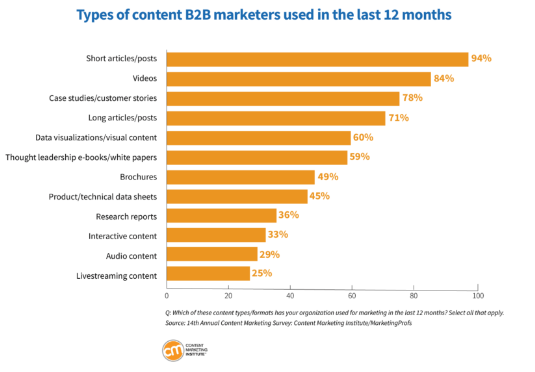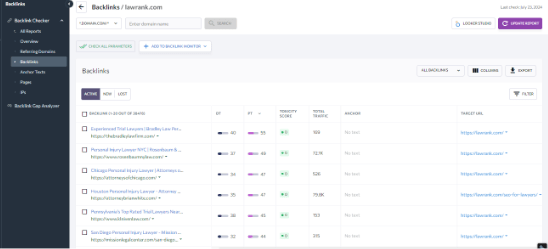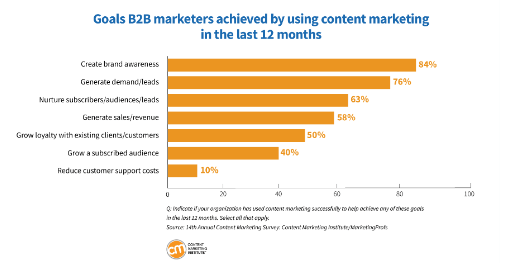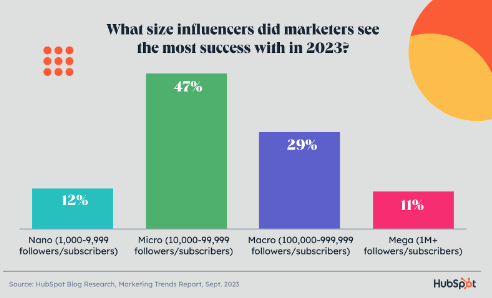Top 10 B2B Content Distribution Strategies That Work

Top 10 B2B Content Distribution Strategies That Work
Producing smart, relevant, high-quality content is just the beginning. With a robust content distribution strategy for your B2B business, you can turn that content into awareness, leads, sales, and loyalty.
If a tree falls in a forest, but there's no one around to hear it, does it make a sound? The same philosophy can be applied to content distribution. If you create and deliver content, but nobody seems to read it, did it make an impact?
Developing a strategic, agile B2B content distribution strategy allows you to publish and promote content through various channels and media formats to maximize reach, build brand awareness, and solidify authority.
According to the Content Marketing Institute, 45% of B2B content marketers expect to bolster their content marketing budget in 2024. Moreover, 84% of B2B marketers say effective content marketing helped create brand awareness, while 58% said it helped generate sales and revenue in the past 12 months.
Do you need help figuring out where and how to build a strong B2B content distribution strategy? This comprehensive guide will illustrate the top 10 workable strategies.
Top 10 B2B Strategies for Content Distribution
A strategic and highly targeted content distribution strategy can be a powerful tool in B2B marketing. Generating content quickly and sharing it haphazardly by tossing content into the void and hoping it sticks.
Let's take a look at the top 10 content distribution strategies for effective B2B marketing:
- Collaborate with relevant influencers
- Create Custom Content for Each Platform
- Repurpose and Amplify Existing Content
- Publish Content On Relevant Websites
- Promote on Social Media
- Leverage PPC Advertising
- Optimize Your Distribution Approach
- Gather Input From Readers
- Conduct Regular Content Audits
- Analyze, Refine, and Adapt Your Content
1. Collaborate With Relevant Influencers
Influencer marketing strategies are an excellent way for B2B marketers to extend the reach of their content, connect with a broader audience, and build brand awareness.
According to Hubspot, 86% of marketers cited influencer marketing as an effective strategy for their organization in 2023. Additionally, 50% of marketers who use it say they plan to increase their influencer marketing investment in 2024, while 20% who have never tried it plan to do so for the first time this year.
To build and leverage a strong influencer content marketing strategy:
- Define the size of influencer that is relevant and fits your budget: nano influencers, micro-influencers, macro influencers, and celebrities
- Find influencers using inbound (landing page or social media announcements) or outbound strategies (Google search and in-depth research, social media platform search, influencer marketing search tools)
- Select the right B2B influencers for your brand and build a relationship with the influencer to create mutual value. Co-create engaging content and cross-amplify content across your networks.
- Research how other competing brands are leveraging influencer marketing and identify topics and media that work and resonate best with your audience.
- Co-create creative, relevant, and authentic content with them based on your business goals that speak to your brand's appeal and USP. Examples include podcast interviews, guest blog posts, webinars, industry events, endorsements, video series, account takeovers, brand ambassador programs, commercials, and more.
- Promote and amplify your influencer content on relevant channels, and take the time to respond to and engage with commentators and listeners. Continuously monitor and measure results and identify if there is a correlation between traffic spikes on your website and social channels throughout the campaign.
2. Create Custom Content for Each Platform
There is no one-size-fits-all when it comes to both content creation and content distribution strategies.
After creating unique, highly compelling content, develop a strategy to leverage it to its best potential by tailoring it to each channel. Various channels can be utilized to build awareness, establish authority, and generate potential leads or revenue.
From blog posts and social media posts to podcasts, videos, and white papers, each platform warrants a different approach to creating, packaging, and promoting your content.
According to the Content Marketing Institute, short articles and posts, videos, case studies, and customer stories were the most popular types of content used by B2B marketers in 2023.

Here are a few different kinds of content that should be strategically utilized and molded for different platforms to yield the best ROI for your B2B content distribution strategy:
Micro-content
Micro-content, which includes short, bite-sized pieces of content like videos, social media updates, infographics, GIFs, memes, images, and lists, is a powerful tool to address the current ubiquitous problem of short customer attention spans. Crafting micro content succinctly and impactfully is an art, but distributing it successfully to convey your message in limited space channels can be powerful in engaging audiences.
Crafting micro content succinctly and impactfully is an art, but distributing it successfully to convey your message in limited space channels can be powerful in engaging audiences.
Search Engine Optimization (SEO)
SEO content allows businesses to ensure their website is as search engine-friendly as possible, boosting site visibility, generating organic traffic, improving brand awareness, and driving potential leads and revenue.
One crucial aspect is technical SEO, where you should optimize your website for search engine bots to navigate and index the pages easily. When you are into B2B, you should focus on resolving javascript errors and 404s that would break its SEO performance and reduce sales.
Geotargeting is an excellent way to deliver the right content to the target audience by location. With the help of IP geolocation API, you can create relevant options for website visitors and customize content to specific regions and cities. Incorporating optimized content helps ensure you identify suitable topics and that your content successfully answers the questions your audience is asking on search engines.
Brand Storytelling
Storytelling is a critical aspect of B2B content marketing and distribution strategies. It helps set your brand apart, captures attention, and builds trust and connection with your audience. It also helps amplify your message and brand value proposition effectively.
Weave storytelling into your content marketing strategy using case studies, employee experiences, industry trends, and customer success stories to illustrate your brand story, values, and voice.
Successful brand storytelling allows you to engage your audience emotionally, showcase your brand narrative, and highlight how your brand, product, and service deliver real-world impact.
Expert Views
Integrate content that contains expert insights, original perspectives, and data-backed research to showcase your organization's expertise and industry authority.
B2B content that focuses on fostering in-depth conversations with plenty of specific insights, great conversations, and offering something new. For example, when doing content marketing for law firms, thought leadership and expert view content will help diversify your lawyers’ content and help your business stand out in an overcrowded market. It also serves as an opportunity to provide keen insights about your solutions and services.
Cultural Marketing
Multicultural marketing tailors marketing content and media to focus on specific cultural groups, traditions, and events. This strategic element of B2B content marketing allows organizations to forge a stronger connection and understanding with one particular, diverse customer audience.
Sam Meenasian, founder of USA Business Insurance, recommends the following: “You should conduct thorough research to understand their needs, partner with organizations that amplify these communities, and use a variety of content formats to share your message widely.”
3. Repurpose & Amplify Existing Content
Generating relevant and impactful content is not always about reinventing the wheel.
Building brand visibility and credibility takes time. However, to be genuinely effective, content development should always focus on quality rather than quantity. According to HubSpot's 2024 State of Marketing Report, 83% of marketers said creating high-quality content less often is more effective than churning out high volumes of subpar content.
To strategically balance both goals, repurpose insights and valuable snippets from your existing content by turning them into engaging micro-content.
Start by identifying the top-performing pieces of content that resonate best with your audience. Gather interesting data, quotes, listicles, or images from the content and repurpose them into different formats, such as social media posts, infographics, video snippets, etc.
Tailor the content and language for various channels to cater to different audiences and content consumption habits. Finally, post on your selected channels 2-3 times a week and continue building the content pipeline with your top-performing content every month.
4. Publish Content On Relevant Websites
Publishing fresh content does not have to be restricted to your organization's website, blog, and official social media channels. Identify opportunities to publish content via relevant websites to share new insights, establish brand authority and credibility, and increase engagement and conversions.
For example, high-quality thought leadership and guest articles on relevant, popular websites can help elevate brand awareness, attract quality leads, and help build a foundation for your organization as an industry leader.
To find relevant and credible websites for guest posting, you can use the right backlink checker tool like SE Ranking to research websites that accept and publish topics similar to yours and have identical metrics (DA and organic traffic).

You can analyze links on any potential website, finding anchor texts, sources, and quality of links leading to your site or competitors. That helps you find new guest posting opportunities and manage existing ones.
Besides guest posting, another effective vehicle for content distribution is press release distribution, normally achieved through newswires. A newswire is an online service that takes paid press release submissions from different PR agencies and businesses, and distributes them globally to news outlets and journalists. This provides journalists with easy access to lots of current stories, and companies with a simple way to get their announcements to the press and their target audience.
Recently, a new trend has emerged: niche-focused newswires, which distribute press releases to leading outlets but only in the niche relevant to the company. For example, a company called MediaFuse has opened 4 niche newswires to date: Chainwire (crypto and blockchain), FinanceWire (finance and fintech), CyberNewsWire (cybersecurity) and GamingWire (gaming). Each newswire integrates with top media outlets, ensuring businesses reach relevant industries and avoid wasting their budget on irrelevant ones.
5. Promote on Social Media
To harness social media's power successfully, tailoring and optimizing content for each platform is critical. For example, X warrants shorter, pithier content, while LinkedIn posts should be a little longer, insightful, and encouraging interactions.
Encourage viewers to engage in conversations, ask questions, share insights, and connect with you on each platform to foster insightful conversations and build communities.
Beyond organic posts, paid promotional content that features compelling imagery, content, or even videos is an effective and efficient way to amplify your messaging and content to even more people and extend your reach.
6. Leverage PPC Advertising
B2B pay-per-click (PPC) advertising is a digital marketing strategy that allows businesses to promote their solutions and services using paid search campaigns. Selecting the right platforms that align with your campaign goals, target audience, and industry is imperative to ensure all your hard work and efforts in B2B content distribution are go amiss.
Pairing a data-backed, laser-targeted PPC campaign with a strong SEO strategy and persuasive ad copy with a clear call-to-action helps ensure optimal results and more significant ROI. Regularly monitor and analyze campaign data by reviewing A/B testing, conversion tracking, targeting options, and other campaign data to gain deeper insights, make data-driven decisions, and optimize your campaigns.
7. Optimize Your Distribution Approach
Optimizing your B2B content distribution strategy requires a proactive approach, not a reactive one. While populating your website and channels with impeccable content is a great start, distributing that content strategically and effectively helps ensure your B2B content marketing strategy is successful.
To ensure your quality content successfully reaches its intended audiences and delivers both impact and ROI, it is essential to:
- Identify and determine the right key performance indicators (KPIs) to be monitored based on business goals, marketing strategy, and selected distribution channel
- Monitor and analyze content performance based on channel, topic, KPI, engagement, lead generation, etc., to identify what is and isn't working, what is missing, and pivot if necessary.
- Monitor audience engagement and content distribution performance on your social channels and website leveraging Google Analytics, social media analytics dashboards, blog and website performance, etc. That will enable you to evaluate your strategy, reevaluate it using data and analytics, and recalibrate it to optimize your next campaign.
To succeed in content marketing, you should continuously test, analyze, and update. This ongoing learning process helps you determine what works for your audience and goals. It ensures that your content always reaches the right people in the right places at the right times.
8. Gather Input From Readers
What better way to understand what content your audience wants to read, watch, and share than through reader feedback? Integrating ways to engage with your audience to understand what types of content they prefer, their likes, dislikes, interests, and pain points will help strengthen your B2B content pipeline. It also communicates to your audience that you are listening to them, integrating quality improvements, and tailoring your content to meet real-world feedback.
Collect and evaluate feedback from multiple channels and sources, such as surveys, polls, social media engagement, blog post comments, online reviews, email responses, and more. Leverage this feedback to improve the quality of your content and identify the best topics. Use that as a jumping-off point to build a more informed content pipeline that generates greater engagement and improved lead generation.
9. Conduct Regular Content Audits
Conducting regular, systematic, and comprehensive content audits can help you analyze what is working, identify what is not, and optimize your B2B content marketing and distribution strategy.
Start by inventorying and mapping your content, evaluating each piece of content against its KPIs and performance, and assessing content freshness and relevance. Based on these insights, plan the following steps to improve content effectiveness and efficiency for previous and future content.

A content audit can evaluate your content's relevance, quality, and accuracy. It also ensures that your content supports your business goals and meets the needs of your target audience. Additionally, it helps find outdated or unnecessary content that can be deleted or repurposed.
10. Analyze, Refine, and Adapt Your Content
Successful B2B content marketing and distribution is more than a one-and-done process. It is imperative to constantly revisit your content strategy to meet market demands, keep up with content trends, and stay ahead of the competition. Regularly and consistently assess, analyze, refine, test, and update your content and content strategy.
While analyzing your content, it is essential to:
- Pinpoint gaps in your content strategy or pipeline and identify where and how you can provide more excellent value
- Conduct research and stay updated on industry and content trends to draw inspiration, identify opportunities, and craft strategies for content creation.
- Leverage content and social media analysis or performance tools to draw actionable insights into your content development, marketing, and distribution efforts.
Regularly evaluating and optimizing your content can significantly improve its performance. Ensure you always think about who you are trying to reach with your strategy.
Integrate Distribution Into Your Holistic B2B Content Strategy
Developing a winning B2B content distribution strategy is a living, breathing process that evolves with plenty of ebbs and flows for improvement. To craft a successful, well-executed plan, it is essential to incorporate a multifaceted approach to developing and amplifying content across multiple channels and in various formats.
From building brand awareness and authority to generating quality leads, sales, and revenue, a comprehensive, robust B2B content distribution strategy catalyzes B2B marketing efforts.
This valuable guide to B2B content distribution strategies will help you enhance your content marketing plans to deliver a more significant impact and ensure your content hits the correct mark at the right time.


